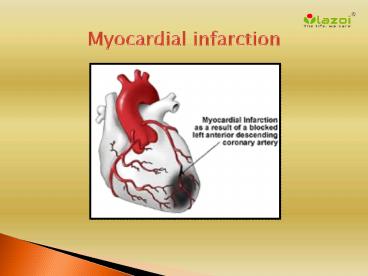Myocardial infarction : Overview, Causes, Symptoms, treatment and diagnosis - PowerPoint PPT Presentation
Title:
Myocardial infarction : Overview, Causes, Symptoms, treatment and diagnosis
Description:
Myocardial infarction: A heart attack. The term "myocardial infarction" focuses on the myocardium (the heart muscle) and the changes that occur in it due to the sudden deprivation of circulating blood. The main change is necrosis (death) of myocardial tissue. – PowerPoint PPT presentation
Number of Views:408
Title: Myocardial infarction : Overview, Causes, Symptoms, treatment and diagnosis
1
Myocardial infarction
2
Myocardial infarction
- Myocardial infarction is the medical name for
a heart attack. Heart attacks occur when the flow
of blood to the heart becomes blocked. They can
cause tissue damage and can even be
life-threatening. - The heart requires its own constant supply of
oxygen and nutrients, like any muscle in the
body. - The heart has three coronary arteries, two of
them large, branching arteries that deliver
oxygenated blood to the heart muscle. - If one of these arteries or branches becomes
blocked suddenly, a portion of the heart is
starved of oxygen, a condition called "cardiac
ischemia." - If cardiac ischemia lasts too long, the starved
heart tissue dies. This is a heart attack
3
Symptoms
- Symptoms of myocardial infarction
- In many cases there may be no symptoms, but 25
of the heart attacks show symptoms. Treating the
symptoms at correct time can always rescue
patients. Symptoms may include - Tightness in the chest
- Pain in the chest, back, jaw, and other areas of
the upper body that lasts more than a few minutes
or that goes away and comes back (this may be the
most early sign of heart attack) - Shortness of breath
- Sweating
- Nausea
- Vomiting
- Anxiety
- Dizziness
- Fast heart rate
4
Diagnosis of myocardial infarction
- Physical test of the heart beat is the primary
test which is done to know if the heart is
working properly. - Stress test may also be done to see the beating
of heart during any intense physical exercise. - Measuring of blood pressure
- An electrocardiogram, to measure the hearts
electrical activity - An angiogram, to look for the areas where the
arteries are blocked - An echocardiogram, to look for the areas of the
heart that arent working properly.
5
Causes of myocardial infarction
- Most of the heart attacks are the result of
atherosclerosis or "hardening of the arteries," a
condition that clogs coronary arteries with
fatty, calcified plaques over time. - Inflammation may also be the cause of heart
attack, coronary artery walls become inflated
over time, further increasing the build up of
fatty plaques. - Bad cholesterol- Bad cholesterol, also
called low-density lipoprotein (LDL), is one of
the leading causes of a blockage in the arteries. - Saturated fat-Saturated fats also contribute to
the build up of plaque in the coronary arteries.
This fats are mostly found meat and dairy
products, including beef, butter, and cheese - Trans fat- Another fat which can lead to the
clogging of arteries are trans fat or
hydrogenated fat which is artificially created.
6
Risk factors of myocardial infarction
- Though anyone can have myocardial infarction, but
there may be some risk factors. This may include - High blood pressure
- Hugh cholesterol level
- High triglyceride level
- Age (Men are at higher risk after age 45 and
women after 55) - Obesity
- Diabetes/ High blood sugar level
- Family history
- Smoking
7
Treatment
- Treatments of myocardial infarction
- Heart attack in most cases are emergency, in such
cases surgical methods are used - Procedure called angioplasty may be used to
unblock the arteries that supply blood to the
heart. - In some cases coronary artery bypass graft
(CABG) is done. In this procedure, the surgeon
will reroute the veins and arteries so the blood
can flow around the blockage. - Certain medications can also be used to treat
heart attack, which may include - Blood thinners, such as aspirin, are often used
to break up blood clots and improve blood flow
through narrowed arteries.
8
Treatment
Continue
- Thrombolytics are often used to dissolve clots.
- Antiplatelet drugs, such as clopidogrel, can be
used to prevent new clots from forming and
existing clots from growing. - Nitroglycerine can be used to widen the blood
vessels. - Beta-blockers lower the blood pressure and relax
the heart muscle. This can help limit the
severity of damage to the heart. - ACE inhibitors can also be used to lower blood
pressure and decrease stress on the heart.
9
Complications of myocardial infarction
- Depending on the severity of the heart attack,
certain other complications can alaso occur, such
as - Heart failure
- Arrhythmias or abnormal heart rhythms
- Cardiac arrest or sudden cardiac death, where the
heart stops beating. - Cardiogenic shock, where the heart is so damaged
from the heart attack that a person goes into
shock, which may result in damage of other vital
organs like the kidneys or liver - Death
- Myocardial infarction can be treated, and
certain fatality can be minimized if the symptoms
are treated as early as possible.
10
CONNECT WITH US
- Logon to
- www.lazoi.com
- Like us on Facebook
- https//www.facebook.com/LazoiTheLife
- Follow us on Twitter
- https//www.twitter.com/lazoithelife
- Follow us on Pinterest
- https//www.in.pinterest.com/lazoithelife































